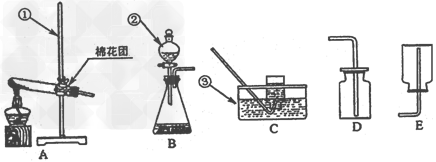请根据下图所示的实验装置图填空。

(1)指出图中标有数字的仪器的名称:①________ ,② _______,③_______。
(2)在实验室里若用高锰酸钾制氧气时,发生装置可选用______ (填字母编号),收集装置可选用 _______(填字母编号),有关反应的文字表达式:_______________________;检验集气瓶中收集的气体是不是氧气时应采用的方法是:_________________;加热时装置A中试管口必须塞一团棉花的目的是: _______________;该实验的步骤大致有
①加热,②收集气体,③检查装置的气密性,④装入高锰酸钾,⑤将试管固定在铁架台上,⑥熄灭酒精灯,⑦将导管移出水面。
请按正确的操作顺序将以上步骤的序号写在横线上:_________,上述操作中若⑥⑦顺序颠倒,则后果是__________。
(3)若用B装置制取氧气时,仪器②内盛放的液体药品是__________,B中锥形瓶内盛放的固体粉末是二氧化锰,它做为反应的___________剂, 若要得到比较干燥的氧气,应该选择________作为收集装置,有关反应的文字表达式:_________,该装置中采用分液漏斗的优点是(只要求写一点):_______________。
(4)实验室选用上述B装置还可用来制取的气体有__________ (只要求写一种), 收集装置可选用__________(填字母编号),选用的理由是:_____________,写出实验室制取该气体的反应文字表达式:________________。
(5)甲烷是一种没有颜色,难溶于水,密度比空气小的气体。李红同学用加热醋酸钠和碱石灰的固体混合物制取甲烷,她应选择的发生装置为 (填字母编号),收集装置为____________(填字母编号)。
(1)①铁架台 ;②分液漏斗 ;③水槽
(2)A; C或D; 高锰酸钾  锰酸钾 + 二氧化锰 + 氧气;用带火星的木条伸入集气瓶中,若木条复燃,则证明该气体是氧气;防止高锰酸钾粉末进入导管,堵塞导管;③④⑤①②⑦⑥; 水槽中的冷水会倒流到热的试管中,使试管骤冷而破裂
锰酸钾 + 二氧化锰 + 氧气;用带火星的木条伸入集气瓶中,若木条复燃,则证明该气体是氧气;防止高锰酸钾粉末进入导管,堵塞导管;③④⑤①②⑦⑥; 水槽中的冷水会倒流到热的试管中,使试管骤冷而破裂
(3)双氧水; 催化剂; D; 过氧化氢 水 + 氧气; 便于控制反应的开始与结束(或便于控制反应速率或便于节约液体药品等)
水 + 氧气; 便于控制反应的开始与结束(或便于控制反应速率或便于节约液体药品等)
(4)二氧化碳; D; 二氧化碳的密度比空气大且不与空气反应;碳酸钙 + 稀盐酸 → 氯化钙 +水 + 二氧化碳
(5)A; C或E
